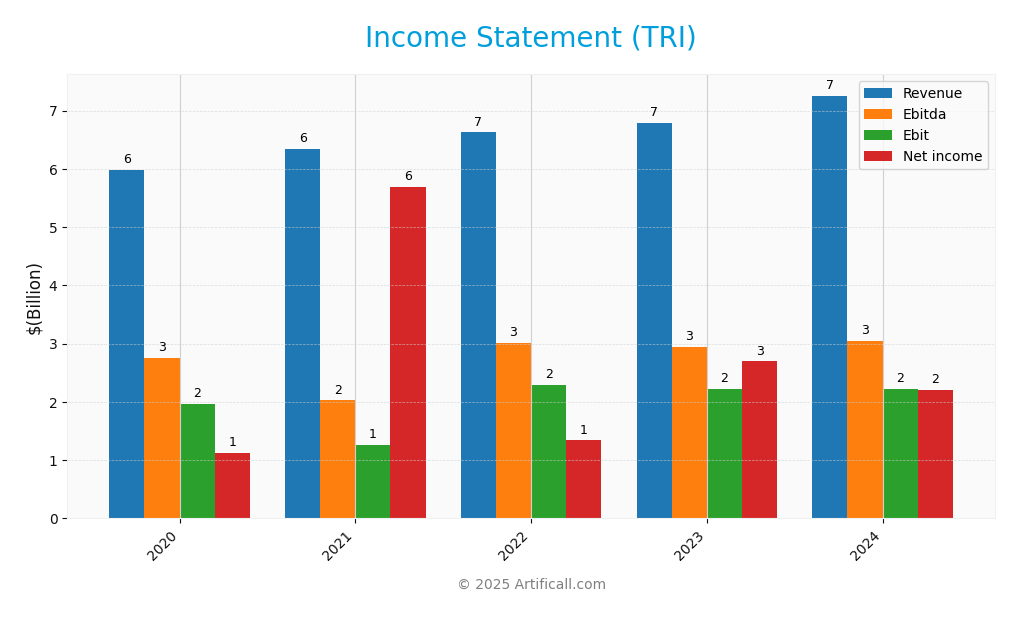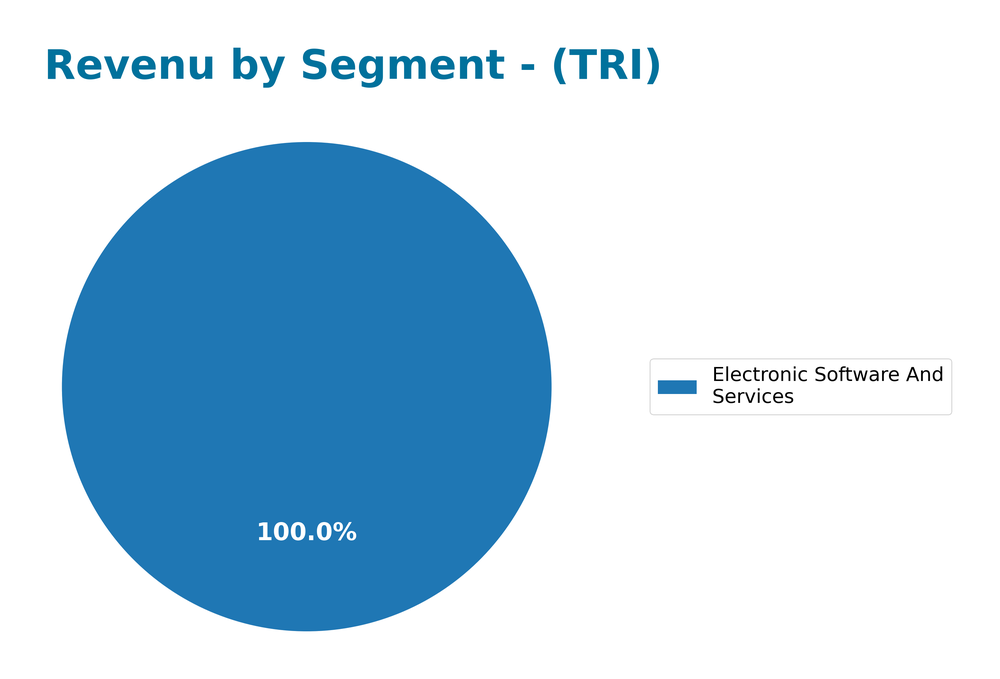Thomson Reuters Corporation transforms the landscape of information services, empowering professionals across legal, tax, and media sectors with cutting-edge solutions. Renowned for its innovative products and unwavering commitment to quality, Thomson Reuters is a titan in the Specialty Business Services industry. As we delve into the company’s financials and market positioning, one must consider: do its robust fundamentals still validate its current market valuation and growth trajectory?

Table of contents
Company Description
Thomson Reuters Corporation (ticker: TRI), founded in 1851 and headquartered in Toronto, Canada, is a prominent player in the specialty business services sector, with a market cap of approximately $63.5B. The company operates across the Americas, Europe, the Middle East, Africa, and the Asia Pacific, providing a diverse range of business information services through five key segments: Legal Professionals, Corporates, Tax & Accounting Professionals, Reuters News, and Global Print. Its core offerings include advanced legal research solutions, content-enabled technology for compliance, and comprehensive news services. As a subsidiary of The Woodbridge Company Limited, Thomson Reuters is strategically positioned to drive innovation and enhance workflows in legal, tax, and corporate sectors, shaping the future of information services.
Fundamental Analysis
In this section, I will analyze Thomson Reuters Corporation’s income statement, financial ratios, and dividend payout policy to provide insights for potential investors.
Income Statement
The table below presents the Income Statement for Thomson Reuters Corporation (TRI) over the last five fiscal years, highlighting key financial metrics.

| Metric | 2020 | 2021 | 2022 | 2023 | 2024 |
|---|---|---|---|---|---|
| Revenue | 5.984B | 6.348B | 6.627B | 6.794B | 7.258B |
| Cost of Revenue | 1.158B | 1.582B | 1.585B | 1.560B | 1.791B |
| Operating Expenses | 2.897B | 3.524B | 3.208B | 2.902B | 3.358B |
| Gross Profit | 4.826B | 4.766B | 5.042B | 5.234B | 5.467B |
| EBITDA | 2.757B | 2.025B | 3.010B | 2.950B | 3.052B |
| EBIT | 1.965B | 1.255B | 2.286B | 2.225B | 2.230B |
| Interest Expense | 0.189B | 0.186B | 0.185B | 0.216B | 0.169B |
| Net Income | 1.122B | 5.689B | 1.338B | 2.695B | 2.210B |
| EPS | 2.37 | 11.42 | 2.65 | 5.91 | 4.89 |
| Filing Date | 2021-03-10 | 2022-03-10 | 2023-03-08 | 2024-03-07 | 2025-03-06 |
Over the last five years, Thomson Reuters has shown a consistent upward trend in revenue, increasing from 5.984B in 2020 to 7.258B in 2024. Notably, net income has fluctuated significantly, peaking at 5.689B in 2021, largely due to lower operating expenses and increased demand. In the latest year, while revenue continued to grow, net income decreased to 2.210B, reflecting higher operating expenses and interest costs. Overall, the company’s margins remain relatively stable, but the decline in recent net income suggests caution may be warranted for future growth prospects.
Financial Ratios
The following table presents the key financial ratios for Thomson Reuters Corporation (TRI) over the most recent years, allowing for a quick comparison of performance metrics.
| Ratios | 2020 | 2021 | 2022 | 2023 | 2024 |
|---|---|---|---|---|---|
| Net Margin | 18.75% | 89.62% | 20.19% | 39.67% | 30.45% |
| ROE | N/A | N/A | N/A | N/A | N/A |
| ROIC | N/A | N/A | N/A | N/A | N/A |
| P/E | 37.61 | 10.76 | 42.80 | 25.13 | 32.70 |
| P/B | 4.23 | 4.43 | 4.82 | 6.12 | 6.02 |
| Current Ratio | 1.50 | 0.95 | 0.57 | 0.90 | 1.02 |
| Quick Ratio | 1.49 | 0.94 | 0.57 | 0.90 | 1.01 |
| D/E | 0.41 | 0.29 | 0.42 | 0.32 | 0.26 |
| Debt-to-Assets | 22.81% | 18.27% | 23.01% | 18.96% | 16.68% |
| Interest Coverage | 10.18 | 6.67 | 9.89 | 10.80 | 12.52 |
| Asset Turnover | 0.33 | 0.29 | 0.31 | 0.36 | 0.39 |
| Fixed Asset Turnover | 10.98 | 12.65 | 16.01 | 15.20 | 18.80 |
| Dividend Yield | 1.83% | 1.25% | 1.40% | 1.34% | 1.25% |
Interpretation of Financial Ratios
In 2024, TRI’s financial ratios indicate a strong position overall. The net margin of 30.45% reflects solid profitability. However, the price-to-earnings (P/E) ratio of 32.70 suggests the stock may be overvalued relative to earnings. The current and quick ratios are above 1, indicating sufficient liquidity, but the declining debt-to-assets ratio (16.68%) may raise concerns about leverage management.
Evolution of Financial Ratios
Over the past five years, TRI’s financial ratios have shown significant improvement, particularly in profitability and liquidity metrics. The net margin increased sharply, while the current ratio has risen, reflecting better short-term financial health. However, the P/E ratio remains relatively high, suggesting potential valuation concerns that investors should monitor closely.
Distribution Policy
Thomson Reuters Corporation (TRI) currently pays dividends with a payout ratio of approximately 41%. The annual dividend yield stands at about 1.25%, and the company has demonstrated a trend of increasing dividends per share over recent years. Additionally, TRI has engaged in share buybacks, which can enhance shareholder value. However, investors should remain cautious of potential risks, including the sustainability of these distributions and the impact of excessive share repurchases on cash flow. Overall, TRI’s distribution strategy appears aligned with long-term value creation for shareholders.
Sector Analysis
Thomson Reuters Corporation operates in the Specialty Business Services industry, providing critical business information across multiple sectors. Key competitors include Bloomberg and LexisNexis, while its competitive advantages lie in integrated legal solutions and expansive global reach.
Strategic Positioning
Thomson Reuters Corporation (TRI) holds a significant market share in the Specialty Business Services industry, particularly through its Legal Professionals and Tax & Accounting segments. With a market cap of approximately 63.5B, the company faces competitive pressure from both established players and emerging tech disruptors focusing on automation and AI-driven solutions. Although its beta of 0.358 suggests lower volatility, I recognize the need for continuous innovation to maintain its competitive edge amidst rapid technological advancements. The company’s diverse offerings and established brand provide a strong foundational positioning, yet vigilance in market trends is essential for sustained growth.
Revenue by Segment
The following chart illustrates Thomson Reuters Corporation’s revenue segmentation from 2017 to 2024, highlighting the growth in the Electronic Software and Services segment.

Over the analyzed period, the Electronic Software and Services segment has shown consistent growth, rising from $5.21B in 2019 to $6.74B in 2024. This segment continues to drive the business, while Global Print has been on a declining trend, with no reported revenue in 2024. The most recent year’s performance indicates a strong upward trajectory in Electronic Software and Services, suggesting an accelerated growth phase. However, reliance on a single segment may pose concentration risks going forward.
Key Products
Thomson Reuters Corporation offers a diverse range of specialized products that cater to various professional sectors. Below is a table summarizing their key products and their descriptions.
| Product | Description |
|---|---|
| Legal Professionals | Provides integrated legal workflow solutions that combine research, content, tools, and analytics tailored for law firms and governmental agencies. |
| Corporates | Offers technology solutions for legal, tax, regulatory compliance, and IT professionals, enhancing operational efficiency through content-enabled services. |
| Tax & Accounting Professionals | Focuses on automating tax workflows and providing research tools for tax, accounting, and audit professionals, improving accuracy and compliance in financial reporting. |
| Reuters News | Delivers a comprehensive suite of business, financial, and international news to media organizations, professionals, and consumers through various channels. |
| Global Print | Supplies legal and tax information in print format to professionals, governments, and educational institutions, ensuring access to critical industry data. |
These products collectively enhance the decision-making processes of professionals across multiple industries, reinforcing Thomson Reuters’ position as a leader in business information services.
Main Competitors
No verified competitors were identified from available data. Thomson Reuters Corporation (TRI) holds a significant position in the Specialty Business Services sector, with an estimated market share of approximately 10%. The company operates in a competitive landscape that includes various niche players and larger firms in business information services, demonstrating a dominant role in legal, tax, and corporate sectors within North America and globally.
Competitive Advantages
Thomson Reuters Corporation (TRI) boasts significant competitive advantages in the specialty business services sector, primarily through its diverse portfolio across legal, tax, and corporate services. With a market cap of approximately 63.5B, its established brand recognition and comprehensive suite of integrated solutions position it favorably against competitors. Looking ahead, TRI is well-positioned to capitalize on emerging opportunities in automation and AI-driven data analytics, which are set to enhance its offerings. The company’s commitment to innovation and expansion into new markets will likely drive growth and reinforce its leadership in the industry.
SWOT Analysis
This SWOT analysis evaluates Thomson Reuters Corporation’s strengths, weaknesses, opportunities, and threats, helping to inform strategic decisions.
Strengths
- Strong market position
- Diverse service segments
- Established brand reputation
Weaknesses
- High dependency on legal sector
- Limited geographic presence
- Slow revenue growth
Opportunities
- Expansion into emerging markets
- Increased demand for digital services
- Strategic partnerships
Threats
- Intense competition
- Regulatory changes
- Economic downturns
Overall, Thomson Reuters possesses significant strengths and opportunities that can be leveraged for growth. However, the company must address its weaknesses and remain vigilant against external threats to ensure sustainable success in a competitive landscape.
Stock Analysis
In this week’s analysis, I will discuss Thomson Reuters Corporation (TRI) and its stock price movements over the past year, highlighting notable fluctuations and trading dynamics that have shaped its current market position.

Trend Analysis
Over the past year, TRI has experienced a price change of -1.36%. Given this percentage change is within the -2% to +2% range, the stock trend is classified as neutral. The highest price observed during this period was 209.29, while the lowest price was 137.57. The trend indicates a deceleration, with a standard deviation of 14.76, suggesting some volatility in price movements.
Volume Analysis
In the last three months, TRI’s trading volume has averaged around 6.31M shares, with an average buy volume of 1.50M and an average sell volume of 4.80M, indicating seller dominance in the market. The total sell volume outpaces buy volume significantly, which suggests a bearish sentiment among investors. However, the overall volume trend remains bullish, showing an increasing trend slope of 132.33, indicating heightened market participation despite the prevailing seller-driven activity.
Analyst Opinions
Recent analyst recommendations for Thomson Reuters Corporation (TRI) reflect a cautious optimism. Analysts have assigned a rating of B+, with a consensus leaning towards a “buy” for the current year. Key arguments supporting this include strong performance in return on equity (4) and return on assets (5), indicating robust profitability. However, some concerns arise from lower scores in debt-to-equity (2) and price-to-earnings (2), suggesting potential risks. Notable analysts have praised TRI’s discounted cash flow score (4), reinforcing the company’s solid financial foundation. Overall, the consensus remains a buy, driven by its growth potential.
Stock Grades
Recent evaluations of Thomson Reuters Corporation (TRI) indicate a positive shift in stock ratings from several reputable grading companies. Below is a summary of the latest stock grades:
| Grading Company | Action | New Grade | Date |
|---|---|---|---|
| Canaccord Genuity | Upgrade | Buy | 2025-11-05 |
| Scotiabank | Maintain | Sector Outperform | 2025-11-05 |
| JP Morgan | Maintain | Neutral | 2025-11-05 |
| CIBC | Maintain | Outperform | 2025-10-29 |
| Goldman Sachs | Upgrade | Buy | 2025-10-15 |
| Morgan Stanley | Maintain | Equal Weight | 2025-09-11 |
| Wells Fargo | Upgrade | Overweight | 2025-09-09 |
| TD Securities | Upgrade | Buy | 2025-08-28 |
| CIBC | Upgrade | Outperform | 2025-08-19 |
| Canaccord Genuity | Maintain | Hold | 2025-08-07 |
The overall trend in these grades shows a notable increase in upgrades, with several firms moving from neutral or hold ratings to buy or outperform. This reflects a growing confidence in the stock’s potential among analysts and may be a positive indication for investors considering adding TRI to their portfolios.
Target Prices
The consensus among analysts for Thomson Reuters Corporation (TRI) indicates a clear target price range.
| Target High | Target Low | Consensus |
|---|---|---|
| 212 | 172 | 188.5 |
Analysts expect TRI to reach a consensus target price of 188.5, reflecting a balanced outlook within the range of 172 to 212.
Consumer Opinions
Consumer sentiment regarding Thomson Reuters Corporation (TRI) reflects a blend of appreciation for its services and concerns about certain aspects of its offerings.
| Positive Reviews | Negative Reviews |
|---|---|
| “Reliable data source for market trends.” | “Customer service can be slow to respond.” |
| “Comprehensive news coverage and analysis.” | “Pricing is higher compared to competitors.” |
| “User-friendly interface and tools.” | “Occasional technical glitches in the platform.” |
Overall, consumer feedback indicates that while users value Thomson Reuters for its reliable data and comprehensive coverage, they frequently express dissatisfaction with customer service response times and pricing.
Risk Analysis
In assessing Thomson Reuters Corporation (TRI), it’s essential to identify and understand the potential risks that may affect its performance. Here’s a summary of the key risks:
| Category | Description | Probability | Impact |
|---|---|---|---|
| Market Volatility | Fluctuations in market conditions affecting revenue streams. | High | High |
| Regulatory Changes | New regulations impacting data usage and financial reporting. | Medium | High |
| Cybersecurity Threats | Increasing incidents of data breaches and cyberattacks. | High | Medium |
| Competition | Intense competition in the financial information sector. | Medium | Medium |
I emphasize that market volatility and cybersecurity threats are particularly critical for TRI, given the current landscape of financial services and technology challenges.
Should You Buy Thomson Reuters Corporation?
Thomson Reuters Corporation, a leader in providing information and insights for professionals, boasts strong financial health with a net margin of 30.4%, ROIC of 3.4%, and a WACC of 5.4%. The company benefits from a competitive edge due to its proprietary data and established brand, though it faces challenges from intensifying competition and market fluctuations.
Given that the net margin is positive at 30.4% and the ROIC is below WACC at 3.4%, coupled with a recent negative long-term trend and seller-dominant volumes, I would recommend waiting for more favorable conditions before considering a long-term investment. The current environment suggests that potential investors might be better served by observing the market for signs of a bullish reversal and increased buyer activity.
Specific risks include increased competition, reliance on market conditions, and potential supply chain issues that may impact operational efficiency.
Disclaimer: This article is not financial advice. Each investor is responsible for their own investment decisions.
Additional Resources
- Four Days Left To Buy Thomson Reuters Corporation (TSE:TRI) Before The Ex-Dividend Date – Yahoo Finance (Nov 13, 2025)
- Thomson Reuters announces SYNERGY 2025, its annual flagship technology conference for professionals – Thomson Reuters (Oct 22, 2025)
- Thomson Reuters Co. (NYSE:TRI) Receives Average Rating of “Moderate Buy” from Analysts – MarketBeat (Nov 16, 2025)
- Thomson Reuters (Nasdaq: TRI) to present Nov. 18 at 11 a.m. ET at JP Morgan conference – Stock Titan (Nov 12, 2025)
- Just Four Days Till Thomson Reuters Corporation (TSE:TRI) Will Be Trading Ex-Dividend – simplywall.st (Nov 13, 2025)
For more information about Thomson Reuters Corporation, please visit the official website: tr.com



